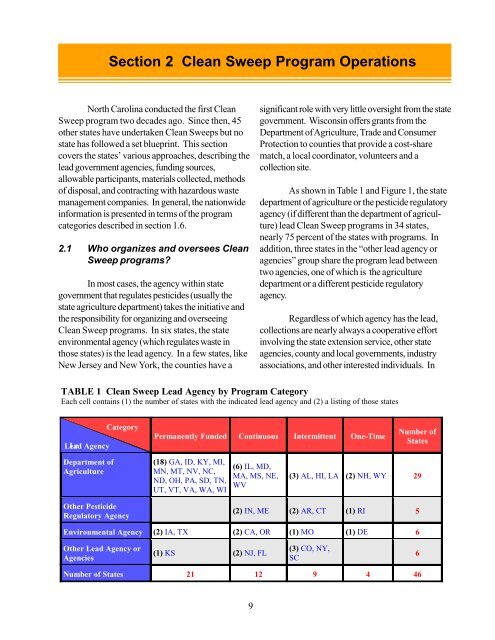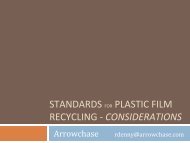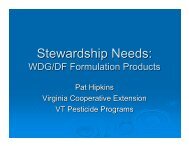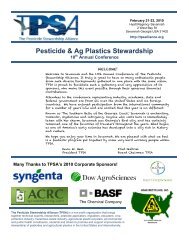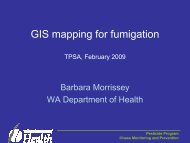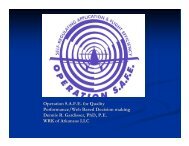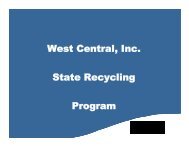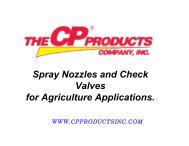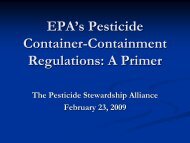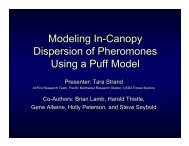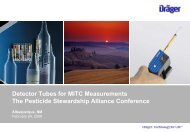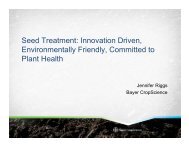Clean Sweep Programs - US Environmental Protection Agency
Clean Sweep Programs - US Environmental Protection Agency
Clean Sweep Programs - US Environmental Protection Agency
- No tags were found...
Create successful ePaper yourself
Turn your PDF publications into a flip-book with our unique Google optimized e-Paper software.
Section 2 <strong>Clean</strong> <strong>Sweep</strong> Program OperationsNorth Carolina conducted the first <strong>Clean</strong><strong>Sweep</strong> program two decades ago. Since then, 45other states have undertaken <strong>Clean</strong> <strong>Sweep</strong>s but nostate has followed a set blueprint. This sectioncovers the states’ various approaches, describing thelead government agencies, funding sources,allowable participants, materials collected, methodsof disposal, and contracting with hazardous wastemanagement companies. In general, the nationwideinformation is presented in terms of the programcategories described in section 1.6.2.1 Who organizes and oversees <strong>Clean</strong><strong>Sweep</strong> programs?In most cases, the agency within stategovernment that regulates pesticides (usually thestate agriculture department) takes the initiative andthe responsibility for organizing and overseeing<strong>Clean</strong> <strong>Sweep</strong> programs. In six states, the stateenvironmental agency (which regulates waste inthose states) is the lead agency. In a few states, likeNew Jersey and New York, the counties have asignificant role with very little oversight from the stategovernment. Wisconsin offers grants from theDepartment of Agriculture, Trade and Consumer<strong>Protection</strong> to counties that provide a cost-sharematch, a local coordinator, volunteers and acollection site.As shown in Table 1 and Figure 1, the statedepartment of agriculture or the pesticide regulatoryagency (if different than the department of agriculture)lead <strong>Clean</strong> <strong>Sweep</strong> programs in 34 states,nearly 75 percent of the states with programs. Inaddition, three states in the “other lead agency oragencies” group share the program lead betweentwo agencies, one of which is the agriculturedepartment or a different pesticide regulatoryagency.Regardless of which agency has the lead,collections are nearly always a cooperative effortinvolving the state extension service, other stateagencies, county and local governments, industryassociations, and other interested individuals. InTABLE 1 <strong>Clean</strong> <strong>Sweep</strong> Lead <strong>Agency</strong> by Program CategoryEach cell contains (1) the number of states with the indicated lead agency and (2) a listing of those statesCategoryLead ad <strong>Agency</strong>Permanently Funded Continuous Intermittent One-TimeNumber ofStatesDepartment ofAgriculture(18) GA, ID, KY, MI,MN, MT, NV, NC,ND, OH, PA, SD, TN,UT, VT, VA, WA, WI(6) IL, MD,MA, MS, NE,WV(3) AL, HI, LA (2) NH, WY 29Other PesticideRegulatory <strong>Agency</strong>(2) IN, ME (2) AR, CT (1) RI 5<strong>Environmental</strong> <strong>Agency</strong> (2) IA, TX (2) CA, OR (1) MO (1) DE 6Other Lead <strong>Agency</strong> orAgencies(1) KS (2) NJ, FL(3) CO, NY,SC6Number of States 21 12 9 4 469


